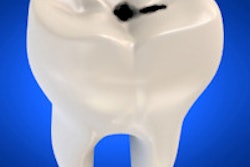
Sooner or later, most of your patients will end up with tooth decay. Brushing and flossing regularly doesn't guarantee decay prevention any more than when you see them twice a year for checkups, cleanings, and fluoride treatments. None of us should give up trying, but there's no surefire way to become absolutely cavity-free.
 John Frachella, DMD.
John Frachella, DMD.Patients miss a few checkups, snack on decay-causing foods, and even ignore sensations of sensitivity that are possible warning signs that they might have a cavity. That's how tooth decay sneaks up on everyone. It becomes discouraging when that happens to our children as they drink soda when we're not looking, say they're brushing and flossing when they're not, or miss dental checkups now and again because they're busy. That's not to say that prevention doesn't work because it does, but only to a certain extent.
To the rescue, enter a new/old way to curb decay's rapid advance that involves the application of liquid silver to already-decayed teeth. Silver nitrate and silver fluoride are liquid silvers that are being used today with great success in managing tooth decay in numerous public and private clinics across the country.
According to multiple dentists' clinical practice data, after using silver on decay, they refer 90% fewer children for hospital dentistry, which is certainly a benchmark for silver's success. Silver solutions are so effective in stopping decay that in Oregon a landmark decision was recently made by the dental board to allow dental assistants and hygienists to apply it under the supervision of a dentist -- a measure that will expand this service to those in Oregon who need it the most.
It's difficult to fight the battle against increased sugar intake by kids even though we know that increased sugar in our diets has created an epidemic of cavities, obesity, and diabetes. Increased sugar consumption is promoted by major corporations who are supported by a multibillion dollar international sugar lobby. Counteracting this offensive requires worthwhile political activism. However, silver remains the best immediate way to treat tooth infection regardless of dietary habits. Regardless, a vast majority of dentists won't use silver because, to them, silver changes the way they do things -- and, like many healthcare providers, dentists resist change.
That's rather ironic because almost a century ago, silver was used by dentists everywhere with considerable success. Silver nitrate solutions were known then (and now) to turn decay (but not an entire tooth) dark, while also killing the bacteria that cause decay. The dark color told patients, parents, and doctors that existing cavities wouldn't spread deeper or wider.
Dr. G.V. Black, the "Father of Modern Dentistry," described how to arrest cavities in children using a precise silver nitrate protocol in 1908. Silver nitrate was used successfully to treat tooth decay in troops being deployed to the front lines in World War I. Dr. Percy Howe, president of the ADA from 1928 to 1929, the first research director of the Forsyth Institute, and a professor at Harvard Dental School) used silver nitrate to stop the growth of decay so routinely between 1917 and 1950 that it became known as "Howe's solution." Dentists used to buy it from a catalogue of dental materials published by the ADA.
“Today, confusion, controversy, and misinformation dominate debates among dentists for and against silver's use.”
Most dentists stopped using silver nitrate more than 50 years ago. Today, confusion, controversy, and misinformation dominate debates among dentists for and against silver's use. That's because silver doesn't fit very neatly into the modern, popular standard of dental care. Dentists are trained in school to be surgeons who cut out decayed tooth structure and replace it with synthetic materials. There's nothing wrong with that because, in the past, that's served dentists and their patients well. Today, however, it's time for a small change -- one that considers using silver again but without abandoning surgical skills.
I first learned about the magic of silver solutions not from a professor in dental school, but from my family dentist, my dad. In 1962, he applied silver nitrate to a small cavity between my permanent lower front teeth. I was 12 years old. The decay never grew, the teeth were never drilled or filled, and now more than 50 years later, there's a small, unnoticeable black dot there.
Why did silver get tossed out? When water fluoridation became the standard of prevention in the 1950's, interest in the use of silver dwindled. Dentists didn't think they'd need it anymore because they figured that water fluoridation would wipe out tooth decay -- but it didn't.
Tooth decay today has risen to epidemic levels in the U.S. (and around the world) despite fluoride in the water, the food chain, and toothpastes, according to a 2012 report from the U.S. Senate Committee on Health, Education, Labor and Pensions.
That report states that 17 million low-income children in the U.S. receive no dental care; 60% of kids age 5 to 17 have cavities; and tooth decay is five times more common than asthma. In Maine in 2010, a state advisory council on health found that dental disease ranked as the most frequent reason for Medicaid-eligible patients to visit hospital emergency rooms. In Oregon in 2014, a state health collaborative found that 77 patients a day arrive in hospital emergency rooms with severe dental problems, a practice that accounts for $8 million in hospital costs that are often shifted to consumers through increasing health insurance premiums.
In the 2012 report, Sen. Bernie Sanders, chair of the U.S. Senate Subcommittee on Primary Health and Aging, declared that the U.S. is in a "caries crisis." Tooth decay is the most common infectious disease in the world. The bacteria that cause its contagion spread from moms and dads to children. That's why we dentists will never be able to dill and fill our way out of this hole.
Part 2 will examine the social and economic aspects of tooth decay and further benefits of treatment.
John Frachella, DMD, is the dental director of Asher Community Health Center federally qualified dental clinics in Wheeler County in Oregon. He is also on staff at the Oregon Health Sciences University School of Dentistry.
The comments and observations expressed herein do not necessarily reflect the opinions of DrBicuspid.com, nor should they be construed as an endorsement or admonishment of any particular idea, vendor, or organization.



















